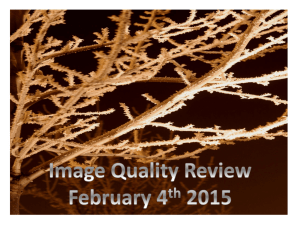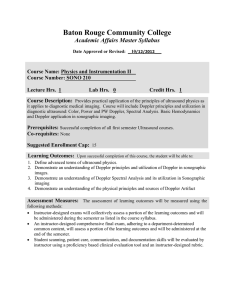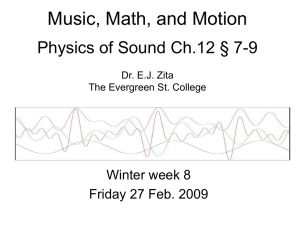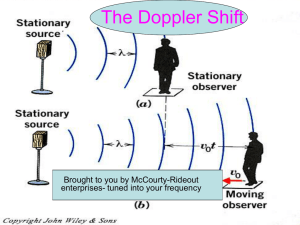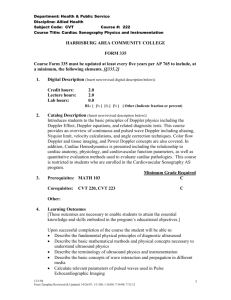Heart wall velocimetry and exogenous contrast-based
advertisement
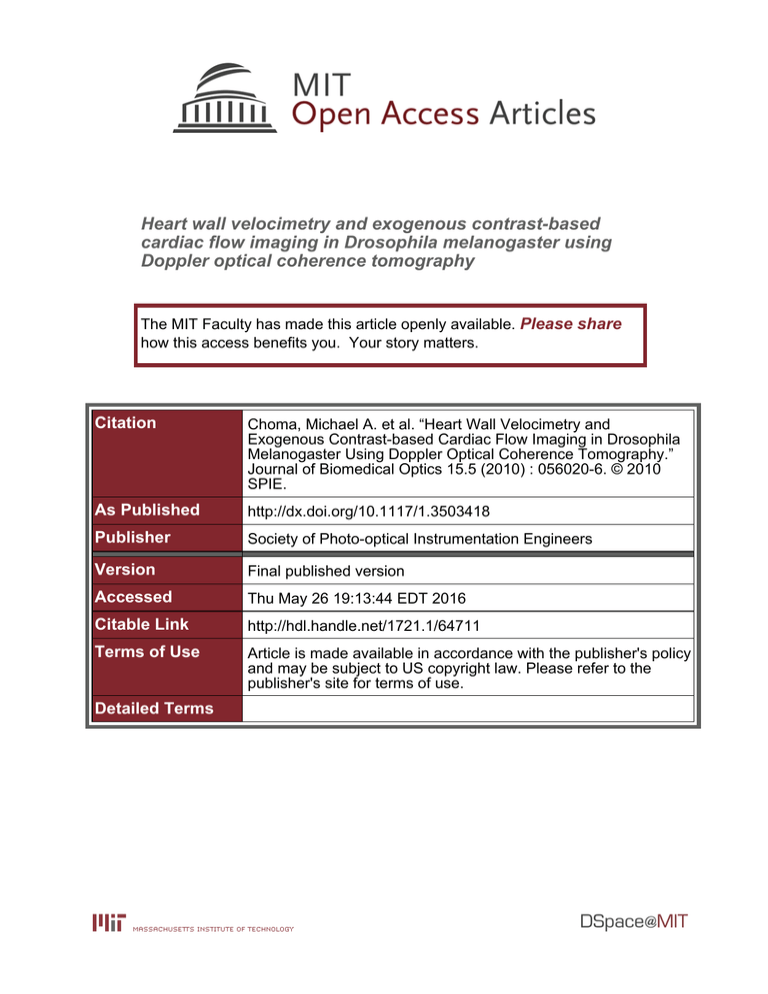
Heart wall velocimetry and exogenous contrast-based cardiac flow imaging in Drosophila melanogaster using Doppler optical coherence tomography The MIT Faculty has made this article openly available. Please share how this access benefits you. Your story matters. Citation Choma, Michael A. et al. “Heart Wall Velocimetry and Exogenous Contrast-based Cardiac Flow Imaging in Drosophila Melanogaster Using Doppler Optical Coherence Tomography.” Journal of Biomedical Optics 15.5 (2010) : 056020-6. © 2010 SPIE. As Published http://dx.doi.org/10.1117/1.3503418 Publisher Society of Photo-optical Instrumentation Engineers Version Final published version Accessed Thu May 26 19:13:44 EDT 2016 Citable Link http://hdl.handle.net/1721.1/64711 Terms of Use Article is made available in accordance with the publisher's policy and may be subject to US copyright law. Please refer to the publisher's site for terms of use. Detailed Terms Journal of Biomedical Optics 15共5兲, 056020 共September/October 2010兲 Heart wall velocimetry and exogenous contrast-based cardiac flow imaging in Drosophila melanogaster using Doppler optical coherence tomography Michael A. Choma Children’s Hospital Boston 300 Longwood Avenue Boston, Massachusetts 02115 and Harvard Medical School Department of Pediatrics Boston, Massachusetts 02115 Melissa J. Suter Massachusetts General Hospital Wellman Center for Photomedicine Boston, Massachusetts 02114 and Harvard Medical School Department of Dermatology Boston, Massachusetts 02115 Abstract. Drosophila melanogaster 共fruit fly兲 is a central organism in biology and is becoming increasingly important in the cardiovascular sciences. Prior work in optical imaging of the D. melanogaster heart has focused on static and dynamic structural anatomy. In the study, it is demonstrated that Doppler optical coherence tomography can quantify dynamic heart wall velocity and hemolymph flow in adult D. melanogaster. Since hemolymph is optically transparent, a novel exogenous contrast technique is demonstrated to increase the backscatter-based intracardiac Doppler flow signal. The results presented here open up new possibilities for functional cardiovascular phenotyping of normal and mutant D. melanogaster. © 2010 Society of Photo-Optical Instrumentation Engineers. 关DOI: 10.1117/1.3503418兴 Keywords: coherent optical systems; Doppler effect; flows; biomedical optics; biology. Paper 09570R received Dec. 22, 2009; revised manuscript received Aug. 31, 2010; accepted for publication Aug. 31, 2010; published online Oct. 29, 2010. Benjamin J. Vakoc Brett E. Bouma Massachusetts General Hospital Wellman Center for Photomedicine Boston, Massachusetts 02114 and Harvard Medical School Department of Dermatology Boston, Massachusetts 02115 and Harvard-MIT Division of Health Sciences and Technology 77 Massachusetts Avenue Cambridge, Massachusetts 02139 Guillermo J. Tearney Massachusetts General Hospital Wellman Center for Photomedicine Boston, Massachusetts 02114 and Harvard-MIT Division of Health Sciences and Technology 77 Massachusetts Avenue Cambridge, Massachusetts 02139 and Harvard Medical School Department of Pathology Boston, Massachusetts 02115 1 Introduction Over the past decade, there has been considerable growth in the literature focusing on the cardiovascular biology of Drosophila melanogaster. In particular, this research has focused on cardiovascular development1 and on using D. mela- Address all correspondence to: Michael A. Choma, Yale University School of Medicine, Department of Diagnostic Radiology, MRRC, TAC N117, P.O. Box 208043, New Haven, Connecticut, 06520-8043. Tel: 203-785-2945; Fax: 203785-6643; E-mail: michael.choma@yale.edu Journal of Biomedical Optics nogaster as a model for human cardiovascular disease.2 Two main categories of innovations have driven this research. First, genetic and genomic technologies continue to increase in sophistication. Examples include the availability of deletion collections with high-resolution genomic coverage3 and gene expression microarrays.4 Second, there are a growing number of nonimaging and imaging technologies that allow for qualitative and quantitative assessment of D. melanogaster heart function. These techniques range from invasive point mea1083-3668/2010/15共5兲/056020/6/$25.00 © 2010 SPIE 056020-1 September/October 2010 Downloaded from SPIE Digital Library on 03 Jun 2011 to 18.51.1.125. Terms of Use: http://spiedl.org/terms 쎲 Vol. 15共5兲 Choma et al.: Heart wall velocimetry and exogenous contrast-based cardiac flow imaging… hearts. Second, intracardiac Doppler OCT flow imaging was achieved by introducing scattering polystyrene microspheres into the open circulation using a novel microinjection technique. Fig. 1 Schematic of the heart 共h兲 and proximal aorta 共ao兲 in adult D. melanogaster.30 Direction of hemolymph inflow through ostia 共o兲 and outflow through the aorta 共ao兲 is indicated by the dashed gray arrows. The heart is located in the abdomen, and the aorta originates near the junction of the abdomen and thorax. OCT imaging in this study focused on the conical chamber 共cc兲, the most anterior portion of the heart. An anterograde beat is characterized by posterior-to-anterior contraction of the heart, while a retrograde beat is characterized by anterior-to-posterior contraction of the heart. surements of heart electrical activity5 to direct optical imaging of dynamic heart anatomy.5–9 Structural optical coherence tomography 共OCT兲 has been previously employed to investigate the dynamic heart function of D. melanogaster.6,7,10 This work builds on prior experience with OCT in vertebrate cardiovascular embryonic imaging.11–19 In addition to focusing on static and dynamic heart anatomy, some of these vertebrate studies imaged blood flow using Doppler OCT.12,15,18 The scattering-related Doppler signal exploited in these studies was generated by endogenous scatterers, i.e., red blood cells. D. melanogaster, however, relies on an extensive tracheal system for oxygen delivery20,21 and, therefore, does not have red blood cells in its circulatory fluid or hemolymph. In fact, the adult hemolymph is relatively transparent when imaged using OCT.6,7 Therefore, exogenous agents are required to perform Doppler-based flow imaging. Being able to perform flow imaging would be useful for detailed phenotyping of normal and mutant D. melanogaster cardiovascular physiology. In addition, flow imaging has the potential to study flow reversal 共Fig. 1兲. Flow reversal is a normal occurrence in D. melanogaster and occurs when the heart switches from anterograde contractions to retrograde contractions or vice versa.22 The specific physiological role of flow reversal in D. melanogaster is incompletely understood and, as such, is an active area of investigation.23 In particular, it is unclear whether heartbeat reversal in D. melanogaster drives shifts in hemolymph volume between body segments to influence tracheal ventilation as it does in insects such as adult butterflies.23 Prior research efforts into the mechanisms behind and physiologic role of flow reversal have focused on heart wall motion22–24 and not directly on flow itself. In addition to providing information regarding cardiovascular flow, Doppler-based imaging can provide information about heart wall motion. In clinical cardiology, heart wall velocimetry using ultrasound imaging25 can be used obtain information about systolic and diastolic function.26 Doppler wall velocimetry using OCT may therefore provide similar information in the imaging of small cardiovascular systems such as D. melanogaster and developing embryos. In this study, we demonstrate the feasibility of using Doppler OCT for quantitatively studying cardiac flow and wall motion in adult D. melanogaster. Two sets of results are presented here. First, B- and M-mode Doppler OCT were used to perform heart wall velocimetry in wild-type adult D. melanogaster Journal of Biomedical Optics 2 Methods 2.1 D. melanogaster Culture, Anesthesia, and Immobilization Flies 共OreR兲 were raised at 24 ° C and fed an instant food media 共Carolina Biological Supply Company, Burlington, North Carolina兲. For contrast injection and imaging, flies were anesthetized with FlyNap 共Carolina Biological Supply Company兲. FlyNap is a volatile mixture of triethylamine 共50%兲, ethanol 共25%兲, and fragrance 共25%兲. After anesthesia, flies were immobilized by taping their wings to a glass slide. 2.2 OCT System and Imaging OCT imaging focused on the conical chamber of the heart 共Fig. 1兲. The principles and operation of the phase-sensitive OCT system used has been previously described.27 Briefly, this optical frequency domain–type OCT system employed a swept laser source with a semiconductor optical amplifier gain medium and a scanning polygon-based wavelength filter. The system operates at a center wavelength of ⬃1300 nm and has an axial resolution of ⬃10 m in air. Imaging was performed at A-line rates of 10 kHz. The sample arm optics have a predicted lateral resolution of 16 m. This OCT system tracks the phase-sensitive time-domain signal by calculating the change between successive A-scans in the phase of the fast Fourier transform of the wave number–domain spectral interferogram. As previously described,27,28 swept laser sources with a mechanical wavelength-tuning element have an intrinsic source of phase instability in that each sweep of the laser has a slightly different starting wave number. In order to correct for this, the phase of an independent stationary sample mirror was recorded in order to establish a zero-phase point when calculating the phase difference on successive A-scans.27 Doppler shifts 共f d兲 were converted to velocity 共v兲 using the usual Doppler equation 关fd = 2v cos共兲n / c; , Doppler angle; n, tissue optical index; , optical frequency; c, free-space vacuum speed of light兴. 2.3 Exogenous Contrast A novel microinjection technique was used to visualize intracardiac flow 共Fig. 2共a兲; Video 1兲. Using a micropipette puller, glass capillary tubes 共outer diameter 1 mm兲 were tapered and then cleaved on a rough surface to a final tip outer diameter of ⬃100 m. Next, 830-nm red polystyrene beads 共Bangs Laboratories, Fishers, Indiana兲 were diluted 3:1 with normal saline. The contrast solution was formulated immediately prior to injection. Particle uniformity was ensured by thoroughly mixing the solution by repeated intake into and ejection from a micropipette tip over the course of ⬃1 min. Injections were performed under a standard stereomicroscope. After manually introducing a contrast agent-filled micropipette into the thorax, contrast was injected by applying 3 psi of pressure applied over 30 ms using a nitrogen-based pressure injection system. Exogenous injection was performed us- 056020-2 September/October 2010 Downloaded from SPIE Digital Library on 03 Jun 2011 to 18.51.1.125. Terms of Use: http://spiedl.org/terms 쎲 Vol. 15共5兲 Choma et al.: Heart wall velocimetry and exogenous contrast-based cardiac flow imaging… Fig. 2 Intraluminal Doppler OCT imaging using exogenous scattering contrast agents. Panel 共a兲 is a still frame taken from Video 1 and shows the microinjection technique. Panel 共b兲 is a structural OCT image of the heart during systole a few minutes after injection of contrast agent into the thorax. Panel 共c兲 has the Doppler OCT image superimposed on the structural OCT image. The Doppler angle is estimated to be 110 deg. Also clearly seen in panel 共c兲 is the Doppler signal generated by the ventral wall. ing light stereomicroscopy guidance. OCT imaging was performed a few minutes after injection. 2.4 Image Processing Images were acquired using custom-designed LabView 共National Instruments, Austin, Texas兲 software. MATLAB 共MathWorks, Natick, Massachusetts兲 and ImageJ29 were used for advanced processing. Doppler signal from areas of low backscatter intensity 共e.g., air, transparent fluid兲 was rejected based on pixel intensity in structural images. 3 Results Fig. 3 High temporal resolution structural and Doppler OCT imaging 共40 frames per second兲 of dynamic anatomy and heart wall velocity during an anterograde 共posterior-to-anterior兲 heart beat in D. melanogaster. Also note that the lumen during systole generated very little backscatter-related signal, and as a consequence, there is essentially no flow-related Doppler signal. diameter of ⬃100 m in this individual fly, the wall velocity normalized to chamber diameter was ⬃10 chamber diameters per second. During systole, the Doppler signals from the ventral and dorsal walls had opposite signs, indicating that the heart wall was moving oppositely. During diastole, the direction of heart wall relaxation was also in a posterior-to-anterior direction. The magnitude of the ventral wall’s Doppler signal during diastole was slightly less than the magnitude during systole. Figure 4 shows an M-mode structural and Doppler OCT Figure 3 shows B-mode structural and Doppler OCT images as the heart completes one cycle of contraction 共i.e., systole兲 and relaxation 共i.e., diastole兲. An anterograde 共i.e., posterior to anterior兲 beat22 is shown. Prior to contraction, there was no organized Doppler signal from the heart wall. During systole, the Doppler signal on the ventral wall clearly traveled from the posterior to anterior aspect of the heart chamber. Futhermore, prior to discernable change in heart chamber diameter, a positive Doppler signal was detected from the posterior aspect of the ventral heart wall. Peak ventral wall velocity in Fig. 2 was ⬃1 m / ms 共 ⬃ 1 mm/ s兲. It was assumed that wall motion was parallel to the direction of sample arm OCT beam propagation. Given a measured dorsal–ventral diastolic Video 1 Injection of exogeneous scattering contrast particles. The first 15 s of the video show microinjection of the particles into the thorax. The last 3 s focus on the heart of the same animal after injection. The heart can be readily identified by red particles that have adhered to its lumen. 共Color online only.兲 共QuickTime, 3.26 MB兲 关URL: http://dx.doi.org/10.1117/1.3503418.1兴. Journal of Biomedical Optics Fig. 4 Dorsal and ventral heart wall velocity 共left panel兲 during systole as measured using M-mode Doppler OCT 共lower-right panel兲. These representative velocity curves were obtained by plotting the maximum 共ventral wall兲 or minimum 共dorsal wall兲 wall velocity at each time point 共i.e., M-mode line兲 from a manual region of interest drawn on each heart wall. Red curves are ventral data, and blue curves are dorsal data. Solid curves represent velocity data, while dashed curves represent displacement 共i.e., integrated velocity兲 data. The upper-right panel shows the equations governing change in chamber diameter measured using structural OCT and calculation of displacement using Doppler velocimetry data. The structural OCT image is shadowed over the Doppler M-mode image. The red/blue 共i.e., positive/negative Doppler shift兲 color map used here is distinct from that used in the other figures and has a very limited dynamic range in order to accentuate the sign, as opposed to the magnitude, of the Doppler shift. EDD, end-diastolic diameter; ESD, end-systolic diameter; vv共t兲, timevarying ventral wall velocity; vD共t兲, time-varying dorsal wall velocity. 056020-3 September/October 2010 Downloaded from SPIE Digital Library on 03 Jun 2011 to 18.51.1.125. Terms of Use: http://spiedl.org/terms 쎲 Vol. 15共5兲 Choma et al.: Heart wall velocimetry and exogenous contrast-based cardiac flow imaging… Video 2 Thoracic injection of an absorptive red dye. Immediately after injection, a “blush” of dye can be seen in the heart. 共QuickTime, 670 KB兲 关URL: http://dx.doi.org/10.1117/1.3503418.2兴. image of the heart during systole. By using M-mode imaging at an A-scan rate of 10 kHz, measurement of wall velocity was obtained in the millisecond regime. The time-varying ventral and dorsal heart wall velocities during systole are plotted. The ventral wall velocity magnitude was slightly larger than that of the dorsal wall velocity. The integrated velocities for each wall corresponded to the total measured change in dorsal–ventral chamber diameter. The total measured change corresponds to the difference between the manually measured end-diastolic diameter 共EDD兲 and the end-systolic diameter 共ESD兲 of the heart lumen along the dorsal–ventral axis. As discussed earlier and as evident from Figs. 3 and 4, adult D. melanogaster hemolymph is essentially transparent. Its transparency is related to its low fractional particle volume 共i.e., percent volume of a fluid mixture that is a cell or another kind of particle兲. The fractional particle volume can in principle be increased by introduction of microparticles into the circulatory flow. Since hemolymph in the extracellular– extravascular space 共e.g., hemocoel兲 flows into the heart via ostia 共Fig. 1兲, any particle injected into the extracellular– extravascular space should flow into the heart, provided that the particle is smaller than the ostia diameter. Since ostia in the adult D. melanogaster have a diameter of ⬃10 m 共Ref. 30兲, microparticles should readily pass into the heart. This was confirmed experimentally 共Fig. 2; Video 1兲. Video 1 is a 15-fps video recording of microparticle microinjection. After introduction of the micropipette into the thorax and injection of the particles, a “blush” of red was seen at the presumed location of the heart just posterior to the thorax–abdomen junction. The distribution and flow of particles appeared directed and not isotropic. After several seconds, the blush cleared. Zooming in on the heart, there was a faint red outline of the heart due to microparticles sticking presumably to the lumen of the heart. As a secondary confirmation of this mode of contrast delivery in the adult D. melanogaster cardiovascular system, red dye 共McCormick and Company, Sparks, Maryland兲 injected into the thorax localized to the heart as observed on video microscopy 共Video 2兲. Structural OCT imaging, performed a few minutes after injection, showed significant intracardiac backscatter signal 共Fig. 2兲, demonstrating that OCT can detect backscatter from a steady-state concentration of microparticles, long after the color of the microparticle is no longer visible in the hemolymph by light microscopy. This backscatter signal enJournal of Biomedical Optics Fig. 5 Intracardiac M-mode Doppler flow imaging several minutes after the injection of exogenous contrast material. Panel 共a兲 shows an extended M-mode recording that captures cardiac reversal. Flow related to anterograde beats generated a negative Doppler shift, while flow related to retrograde beats generated a positive Doppler shift. Systole 共s兲 was determined by the presence of a positive Doppler shift on the ventral heart wall. Panel 共b兲 shows the first retrograde systolic event after asystole, while panel 共c兲 shows the midline velocity profile from 共b兲. Both 共a兲 and 共b兲 have a height of 250 m. abled intraluminal flow imaging using Doppler OCT. The presence of Doppler signal of significant magnitude corresponded with the onset of wall motion as indicated by wall Doppler signal. The flow-related Doppler signal during systole had a negative sign, indicating an anterograde 共i.e., posterior-to-anterior兲 flow. For comparison, note the relative absence of OCT Doppler signal in the heart lumen in the absence of exogenous contrast 共Figs. 3 and 4兲. Overall, seven OCT-confirmed and one video microscopy–confirmed injections of microparticles were successfully completed. Figure 5 shows an extended M-mode recording that demonstrates the phenomenon of cardiac reversal.22 During cardiac reversal, the direction of the heart contractions reverse. Over the course of the 2.16-s M-mode image in Fig. 5共a兲, the heart transitioned from anterograde contraction to asystole to retrograde 共i.e., anterior-to-posterior兲 contractions. As in Fig. 2, flow generated by anterograde contractions generated a Doppler shift with a negative sign. During asystole, there was no significant intraluminal or heat wall Doppler signal. During retrograde contractions, the flow-generated Doppler shift had a positive sign, indicating anterior-to-posterior flow. These results indicate that flow direction can be determined with a one-dimensional spatial flow measurement, whereas heart wall Doppler imaging requires a two-dimensional Doppler measurement 共Fig. 3兲. Figure 5共b兲 shows the first systolic event after the ⬃1.375-s asystolic period, while Fig. 5共c兲 is a plot of the midline intraluminal flow velocity taken over a narrow rectangular region of interest, with each time point representing an average over the spatial dimension of the region of interest. Rapid flow acceleration on the order of 0.1 m / ms2 共 ⬃ 2 m / ms/ 20 ms兲 could be estimated from the flow profile. Formal survival studies after microinjection were not performed. However, in our initial experience with eight flies with imaging-confirmed injection of a scattering contrast agent, flies would live for a few to several hours after injection of the polystyrene microspheres. 056020-4 September/October 2010 Downloaded from SPIE Digital Library on 03 Jun 2011 to 18.51.1.125. Terms of Use: http://spiedl.org/terms 쎲 Vol. 15共5兲 Choma et al.: Heart wall velocimetry and exogenous contrast-based cardiac flow imaging… 4 Discussion The proof-of-principle results shown here represent the first use of Doppler OCT to quantify cardiovascular function in the adult D. melanogaster. Heart wall velocimetry is readily accomplished in the millisecond regime. This is important because the time constant of cardiovascular mechanics are on the order of milliseconds. The open circulatory physiology of this animal is exploited to deliver, in a straightforward manner, scattering contrast agents into the heart, thereby enabling Doppler OCT flow imaging. Moreover, during an anterograde beat, ventral heart wall and intraluminal Doppler signal are readily distinguished from each other. Doppler OCT thus has the potential to enhance the use of adult D. melanogaster as a model of cardiovascular disease. Prior imaging studies have relied on phenotypes 共e.g., heart rate, fractional shortening兲 derived from direct observation and from dynamic structural heart parameters 共e.g., enddiastolic and end-systolic diameters兲.5,6,9,10 Through phasesensitive detection and processing, the repertoire of cardiovascular phenotypes for genetic screens can be expanded to include heart wall velocity and intracardiac flow velocity. Future work on contrast imaging will address three limitations in the present study. First, anesthesia may have direct cardiac effects, and our work has shifted to the prepupal stage when the organism is immobile and anesthesia is not required for cardiac imaging. Second, the increased fractional particle volume of contrast-enhanced hemolymph can increase the hemolymph viscosity. Therefore, future work will focus on minimizing the injected volume of contrast agent while maintaining sufficient backscatter signal for Doppler imaging. Third, intraluminal and heart wall Doppler signal can be difficult to distinguish when they are of the same sign. Differentiation between the two could potentially be made based on the standard deviation of the Doppler signal.31 In this and prior7 studies, the heart wall speckle pattern is relatively static when the heart is at rest but varies rapidly during contraction and relaxation. Such variations in speckle influences the signal-to-noise ratio of the heart wall Doppler signal.32 Although spatial and temporal averaging can improve the signal-to-noise ratio in this context, such prominent variations in speckle can be potentially utilized for heart wall elastography using previously described methods 共see, for example, Ref. 33兲. In addition to its importance in the study of heart development and human cardiovascular disease, D. melanogaster is of biologic interest because it has an open circulation. Open circulations are of evolutionary and physiologic interest. Given that open circulatory dynamics are not as well defined as those of closed circulation, and given a growing appreciation and understanding of the complexity and diversity of open circulations 共see, for example, Ref. 23兲, Doppler OCT in D. melanogaster may have broad interest in biology. Acknowledgments This work was generously supported by the Frederick H. Lovejoy Fund, Children’s Hospital Boston 共MAC兲 and by an American Medical Association Foundation Seed Grant 共MAC兲. We additionally acknowledge funding support from NIH R01HL076398 and NIH R01CA103769 共development of Journal of Biomedical Optics the imaging system兲 and from the Department of Defense Air Force Office of Scientific Research, Medical Free Electron Laser Program FA9550-04-1-0079. References 1. Y. Tao and R. A. Schulz, “Heart development in Drosophila,” Semin Cell Dev. Biol. 18共1兲, 3–15 共2007兲. 2. E. Bier and R. Bodmer, “Drosophila, an emerging model for cardiac disease,” Gene 342共1兲, 1–11 共2004兲. 3. A. L. Parks, K. R. Cook, M. Belvin, N. A. Dompe, R. Fawcett, K. Huppert, L. R. Tan, C. G. Winter, K. P. Bogart, J. E. Deal, M. E. Deal-Herr, D. Grant, M. Marcinko, W. Y. Miyazaki, S. Robertson, K. J. Shaw, M. Tabios, V. Vysotskaia, L. Zhao, R. S. Andrade, K. A. Edgar, E. Howie, K. Killpack, B. Milash, A. Norton, D. Thao, K. Whittaker, M. A. Winner, L. Friedman, J. Margolis, M. A. Singer, C. Kopczynski, D. Curtis, T. C. Kaufman, G. D. Plowman, G. Duyk, and H. L. Francis-Lang, “Systematic generation of high-resolution deletion coverage of the Drosophila melanogaster genome,” Nat. Genet. 36共3兲, 288–292 共2004兲. 4. B. Zeitouni, S. Senatore, D. Severac, C. Aknin, M. Semeriva, and L. Perrin, “Signalling pathways involved in adult heart formation revealed by gene expression profiling in Drosophila,” PLoS Genet 3共10兲, 1907–1921 共2007兲. 5. K. Ocorr, N. L. Reeves, R. J. Wessells, M. Fink, H. S. Chen, T. Akasaka, S. Yasuda, J. M. Metzger, W. Giles, J. W. Posakony, and R. Bodmer, “KCNQ potassium channel mutations cause cardiac arrhythmias in Drosophila that mimic the effects of aging,” Proc. Natl. Acad. Sci. U.S.A. 104共10兲, 3943–3948 共2007兲. 6. M. J. Wolf, H. Amrein, J. A. Izatt, M. A. Choma, M. C. Reedy, and H. A. Rockman, “Drosophila as a model for the identification of genes causing adult human heart disease,” Proc. Natl. Acad. Sci. U.S.A. 103共5兲, 1394–1399 共2006兲. 7. M. A. Choma, S. D. Izatt, R. J. Wessells, R. Bodmer, and J. A. Izatt, “In vivo imaging of the adult Drosophila melanogaster heart with real-time optical coherence tomography,” Circulation 114共2兲, E35– E36 共2006兲. 8. B. Monier, M. Astier, M. Semeriva, and L. Perrin, “Steroiddependent modification of Hox function drives myocyte reprogramming in the Drosophila heart,” Development 132共23兲, 5283–5293 共2005兲. 9. K. A. Ocorr, T. Crawley, G. Gibson, and R. Bodmer, “Genetic variation for cardiac dysfunction in Drosophila,” PLoS ONE 2共7兲, e601 共2007兲. 10. M. J. Allikian, G. Bhabha, P. Dospoy, A. Heydemann, P. Ryder, J. U. Earley, M. J. Wolf, H. A. Rockman, and E. M. McNally, “Reduced life span with heart and muscle dysfunction in Drosophila sarcoglycan mutants,” Hum. Mol. Genet. 16共23兲, 2933–2943 共2007兲. 11. S. A. Boppart, G. J. Tearney, B. E. Bouma, J. F. Southern, M. E. Brezinski, and J. G. Fujimoto, “Noninvasive assessment of the developing Xenopus cardiovascular system using optical coherence tomography,” Proc. Natl. Acad. Sci. U.S.A. 94共9兲, 4256–4261 共1997兲. 12. S. Yazdanfar, M. D. Kulkarni, and J. A. Izatt, “High-resolution imaging of in vivo cardiac dynamics using color Doppler optical coherence tomography,” Opt. Express 1共13兲, 424–431 共1997兲. 13. T. M. Yelbuz, M. A. Choma, L. Thrane, M. L. Kirby, and J. A. Izatt, “Optical coherence tomography—a new high-resolution imaging technology to study cardiac development in chick embryos,” Circulation 106共22兲, 2771–2774 共2002兲. 14. M. W. Jenkins, D. C. Adler, M. Gargesha, R. Huber, F. Rothenberg, J. Belding, M. Watanabe, D. L. Wilson, J. G. Fujimoto, and A. M. Rollins, “Ultrahigh-speed optical coherence tomography imaging and visualization of the embryonic avian heart using a buffered Fourier domain mode locked laser,” Opt. Express 15共10兲, 6251–6267 共2007兲. 15. A. Mariampillai, B. A. Standish, N. R. Munce, C. Randall, G. Liu, J. Y. Jiang, A. E. Cable, I. A. Vitkin, and V. X. D. Yang, “Doppler optical cardiogram gated 2D color flow imaging at 1000 fps and 4D in vivo visualization of embryonic heart at 45 fps on a swept source OCT system,” Opt. Express 15共4兲, 1627–1638 共2007兲. 16. M. W. Jenkins, F. Rothenberg, D. Roy, V. P. Nikolski, Z. Hu, M. Watanabe, D. L. Wilson, I. R. Efimov, and A. M. Rollins, “4D embryonic cardiography using gated optical coherence tomography,” Opt. Express 14共2兲, 736–748 共2006兲. 056020-5 September/October 2010 Downloaded from SPIE Digital Library on 03 Jun 2011 to 18.51.1.125. Terms of Use: http://spiedl.org/terms 쎲 Vol. 15共5兲 Choma et al.: Heart wall velocimetry and exogenous contrast-based cardiac flow imaging… 17. M. W. Jenkins, P. Patel, H. Y. Deng, M. M. Montano, M. Watanabe, and A. M. Rollins, “Phenotyping transgenic embryonic murine hearts using optical coherence tomography,” Appl. Opt. 46共10兲, 1776–1781 共2007兲. 18. A. M. Davis, F. G. Rothenberg, N. Shepherd, and J. A. Izatt, “In vivo spectral domain optical coherence tomography volumetric imaging and spectral Doppler velocimetry of early stage embryonic chicken heart development,” J. Opt. Soc. Am. A 25共12兲, 3134–3143 共2008兲. 19. R. Yelin, D. Yelin, W.-Y. Oh, S. H. Yun, C. Boudoux, B. J. Vakoc, B. E. Bouma, and G. J. Tearney, “Multimodality optical imaging of embryonic heart microstructure,” J. Biomed. Opt. 12共6兲, 064021 共2007兲. 20. J. H. Law and M. A. Wells, “Insects as biochemical models,” J. Biol. Chem. 264共28兲, 16335–16338 共1989兲. 21. T. Burmester and T. Hankeln, “The respiratory proteins of insects,” J. Insect Physiol. 53共4兲, 285–294 共2007兲. 22. D. Dulcis and R. B. Levine, “Innervation of the heart of the adult fruit fly, Drosophila melanogaster,” J. Comp. Neurol. 465共4兲, 560– 578 共2003兲. 23. L. T. Wasserthal, “Drosophila flies combine periodic heartbeat reversal with a circulation in the anterior body mediated by a newly discovered anterior pair of ostial valves and ‘venous’ channels,” J. Exp. Biol. 210共Pt 21兲, 3707–3719 共2007兲. 24. D. Dulcis and R. B. Levine, “Glutamatergic innervation of the heart initiates retrograde contractions in adult Drosophila melanogaster,” J. Neurosci. 25共2兲, 271–280 共2005兲. 25. K. Isaaz, A. Thompson, G. Ethevenot, J. L. Cloez, B. Brembilla, and Journal of Biomedical Optics 26. 27. 28. 29. 30. 31. 32. 33. 056020-6 C. Pernot, “Doppler echocardiographic measurement of low-velocity motion of the left ventricular posterior wall,” Am. J. Cardiol. 64共1兲, 66–75 共1989兲. N. R. Van de Veire, J. De Sutter, J. J. Bax, and J. R. Roelandt, “Technological advances in tissue Doppler imaging echocardiography,” Heart (Br. Cardiac Soc.) 94共8兲, 1065–1074 共2008兲. B. J. Vakoc, S. H. Yun, J. F. de Boer, G. J. Tearney, and B. E. Bouma, “Phase-resolved optical frequency domain imaging,” Opt. Express 13共14兲, 5483–5493 共2005兲. M. A. Choma, A. K. Ellerbee, C. Yang, T. L. Creazzo, and J. A. Izatt, “Spectral-domain phase microscopy,” Opt. Lett. 30共10兲, 1162–1164 共2005兲. W. S. Rasband, ImageJ, National Institutes of Health, Bethesda, MD 共1997–2009兲. N. J. Curtis, J. M. Ringo, and H. B. Dowse, “Morphology of the pupal heart, adult heart, and associated tissues in the fruit fly, Drosophila melanogaster,” J. Morphol. 240共3兲, 225–235 共1999兲. Y. H. Zhao, Z. P. Chen, C. Saxer, Q. M. Shen, S. H. Xiang, J. F. de Boer, and J. S. Nelson, “Doppler standard deviation imaging for clinical monitoring of in vivo human skin blood flow,” Opt. Lett. 25共18兲, 1358–1360 共2000兲. M. A. Choma, A. K. Ellerbee, S. Yazdanfar, and J. A. Izatt, “Doppler flow imaging of cytoplasmic streaming using spectral domain phase microscopy,” J. Biomed. Opt. 11共2兲, 024014 共2006兲. J. M. Schmitt, “OCT elastography: imaging microscopic deformation and strain of tissue,” Opt. Express 3共6兲, 199–211 共1998兲. September/October 2010 Downloaded from SPIE Digital Library on 03 Jun 2011 to 18.51.1.125. Terms of Use: http://spiedl.org/terms 쎲 Vol. 15共5兲
